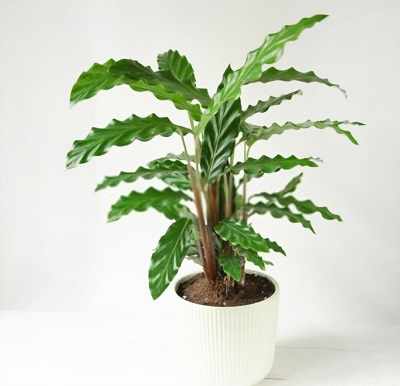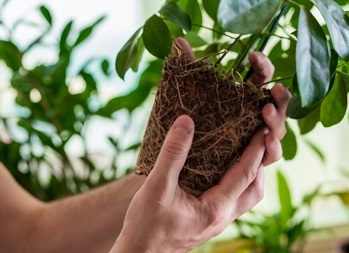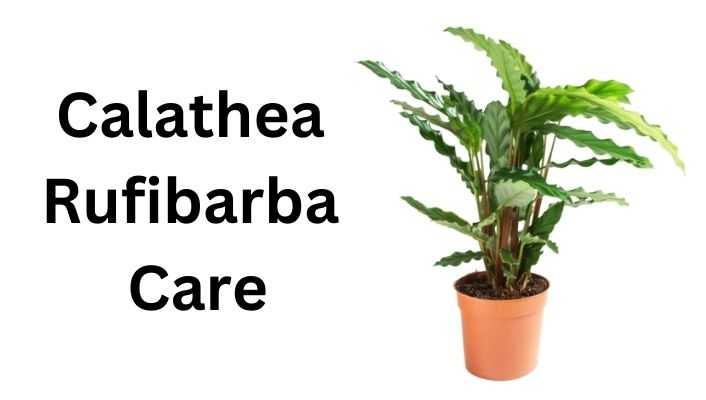The Calathea rufibarba is sometimes also called Goeppertia rufibarba. It is a native plant of the Amazon rainforests in Brazil.
Like most of the other Calathea varieties with many patterns, the Rufibarba is more subtle when it comes to patterns. But, no matter what, it’s perfect and beautiful to be used as a houseplant.
Post Contents
- Characteristics of Calathea Rufibarba
- Size and Growth
- Calathea Rufibarba Care and Maintenance
- Preferred Light Requirements
- Watering the Plant as Per its Needs
- The Right Temperature for Calathea Rufibarba
- Best Kind of Soil
- Humidity Requirements of the Plant
- Fertilizing the Plant
- Cleaning and Maintaining:
- Repotting the Calathea Rufibarba
- Propagation of Calathea Rufibarba
- Toxicity Information
- Pests and Problems of Calathea Rufibarba
- Frequently Asked Questions
- Conclusion
- Author
Characteristics of Calathea Rufibarba
Moving to the beautiful characteristics of this Plant, it has long, thin, and wavy leaves that are light green when young. The mature leaves turn their color into a darker green upper side and maroon to burgundy undersides. The stems of a rufibarba are burgundy in color as well.
Now talking about this Plant’s uniqueness is that the waxy stems and the underside of leaves are covered in hair-like fuzz. These tiny hairs give the Plant a soft and velvety feel. Because of this, many gardeners have given it nicknames such as the fuzzy feather Calathea, velvet Calathea, furry Calathea, and many more.
Related to this post: Calathea Makoyana (Care & Growth Guide)
Size and Growth
The size of the velvety Calathea grows up to 3 feet in height and can form large clusters of leaves quickly.
Keep on reading this article to learn how to care for and maintain the lavish look of this Plant all year round.
Calathea Rufibarba Care and Maintenance
Here’s a guide to having all the essentials for keeping your Plant in perfect and healthy condition.
Preferred Light Requirements
Like all tropical plants, Rufibarba ideally needs bright indirect light, avoiding direct sunlight. Direct sunlight will cause the leaves to fade and lose their markings. They can tolerate shade, but more indirect light will lead to fine foliage.

If you are planning to buy this Plant and bring it to your office or house, make sure it sits at least 3-4 feet from your window to give it enough light.
Despite needing a lot of diffused light, your rufibarba will also survive in a shadier area. But it will not thrive faster and healthier.
Watering the Plant as Per its Needs
As we know that these plants are tropical, so they consistently need lots of moisture and damp soil, but don’t let the soil get soggy because they can’t tolerate sitting in water. Although many plants do well with a soak and dry method of watering, Calathea Rufibarba prefers small drinks frequently.
The pot you use will also affect your watering routine. Always use a terracotta pot because they are porous, while plastic ones are not. The moisture will escape the system faster in a terracotta pot, and that’s exactly what we need.
During the warm seasons, they never let their soil dry out more than an inch from the top. The surface of your potting media should ideally always feel damp.
You will most likely need to water your Plant less during winter. Use room temperature water and always avoid cold water.
Never directly use tap water to water your Rufibarba because the minerals in tap water can negatively affect the Plant’s leaves. Burnt tips and leaf edges may be a sign of mineral burn.
For effective and healthy watering, use filtered, distilled or rainwater.
Quick Tip: Calathea Watering is important for successful Calathea care, so always keep the above information in mind.
You May Also Like: Calathea Orbifolia Care and Growing
The Right Temperature for Calathea Rufibarba
Prefers warm to high temperatures, ideally between 18-23°C, but can cope with as low as 15°C. Avoid draughts and ensure the Plant has reasonable ventilation.
Keep your Plant out of drafty areas, but also ensure good ventilation around the Plant to prevent fungus problems.
The Rufibarba can tolerate temperatures slightly below 18C. But always keep it warm because it will not recover from cold damage.
Best Kind of Soil
The best type of soil mix for this Plant is capable of retaining moisture and draining well. These tropical plants have become very popular, so you can get a decent pre-mixed soil specialized for these plants in most gardening stores.

We will also tell you how you can also mix up your medium. Add moss, rice hull, orchid bark, and perlite to your soil; these additions are nutrient-rich. Plus, they will retain moisture and keep the soil aerated simultaneously.
Humidity Requirements of the Plant
The velvety Calathea loves high humidity. The best humidity levels are above 50%. It will sometimes tolerate lower air humidity. However, if the humidity is too low for too long, the Plant can dry out. You’ll soon see the tips of the leaves drying up, leaves drooping, and the Plant generally looks unwell.
So to avoid this, high humidity levels are a must. Mist your Plant with a sprayer frequently to improve humidity conditions and pop it near the watery areas like the kitchen or washroom from time to give it an extra boost in growth.
Moving to the people who haven’t got all the resources mentioned above, you can always invest in a good humidifier to increase the humidity if you notice your Plant is struggling.
Fertilizing the Plant
Unlike the other Calathea varieties, rufibarba does not show the need for fertilizers to grow well. But you can get it over-fertilized, which is dangerous, so we recommend less fertilizing.
If you notice slow growth, it is recommended to use a low-strength of general houseplant fertilizer rich in nitrogen.
This will encourage vigorous growth during the growing season. You can get a plus point here: though fertilizer is not always needed, it will benefit leaves by enhancing their foliage’s color and growth.
The routine of fertilization should be every 4-6 weeks from March to September. Make sure to dilute the fertilizer to a quarter strength to avoid fertilizer burn to his roots.
Cleaning and Maintaining:
You have to put a lot of effort into the cleaning part because of the density and fuzzy nature of the leaves of Rufibarba.
You can give your Plant a shower with lukewarm water for a nice fresh look. This will keep the leaves dust-free. Be careful while showering the Plant, mind the water pressure, don’t use tap water, and avoid washing out the soil.
Moreover, you can use a soft, warm damp cloth with a drop of cleaning soap. The soap will help to get rid of some pests and keep them away from the Plant.
Occasionally trim off the Plant for any dried leaves. Doing so will help the plant focus on new growth instead of wasting energy.
Repotting the Calathea Rufibarba
Gradually, the furry calathea will outgrow its current pot, or the soil might become soggy and deplete nutrients, especially if you never fertilize your Plant.

Mostly you can repot your Plant every 2 years if it’s growing healthily. Always add fresh soil as it has a lot of nutrients.
Choose a pot one or two sizes bigger than the current pot. Moreover, always opt for a terracotta pot.
Propagation of Calathea Rufibarba
Propagation of Calathea varieties is impossible by rooting them in water. The best way of propagation is that you should do it when repotting the Plant.
Always propagate in early spring, gently shake the old soil off the roots, detangle them, and divide them as needed. You can use your fingers or a sterile, sharp tool to separate them.
Toxicity Information
Calathea Rufibarba is mostly considered nontoxic to pets and humans.
The fuzzy leaves of plants can attract pets. But the point arises that ingesting any plant in larger quantities, even if it’s non-toxic, can cause problems to both the pets and Plant.
Pests and Problems of Calathea Rufibarba
You will surely have problems with pests if you are maintaining high humidity for the Plant. However, Spider mites, mealy bugs, and leaf scales dislike humidity, but they can still be an issue.
To cope with pest-related issues, you can use a diluted alcohol solution to treat visible mealy bugs or colonies of spider mites, but be careful. This can burn the leaves. If your Plant’s leaves are highly infested, remove them and apply a solution of insecticide.
Moreover, fungal diseases can also appear as spots on the leaves. Keep an eye out for that too.
Frequently Asked Questions
Is caring for Calathea Rufibarba hard?
While the Calathea Rufibarba is an easy plant to care for, it is difficult to provide them with the proper nutrition. We recommend you keep it away from other plants for at least 2 weeks.
Can Calathea Rufibarba be kept indoors?
Yes! It is a tropical plant and thrives best indoors if you ensure the right care routine, as mentioned above in the article.
What signs does Calathea Rufibarba show when it is dying?
Calathea leaves start to turn yellow or brown, and, overall, it shows a dying wilted appearance.
Why do Calathea Rufibarba leaves curl up?
The main cause of this is temperature. Leaves start to curl if the Plant is cold or excessively dry.
How do I know if my Calathea is healthy or not?
The roots show their healthiness, and if they are light yellow and firm, your Plant is perfectly healthy.
Conclusion
The Calathea Rufibarba doesn’t have flowers, but it is an extremely beautiful plant. It is the perfect plant for indoor environments, plus it gives an extra dimension to your house or office decoration.
We hope our article covers all the points and tips you need for the care and maintenance of your Plant.
Moreover, if you plan to buy one, it is recommended from our side. Remember to care properly, and you’ll fall in love with this artful Plant.
Read More Related Articles:

